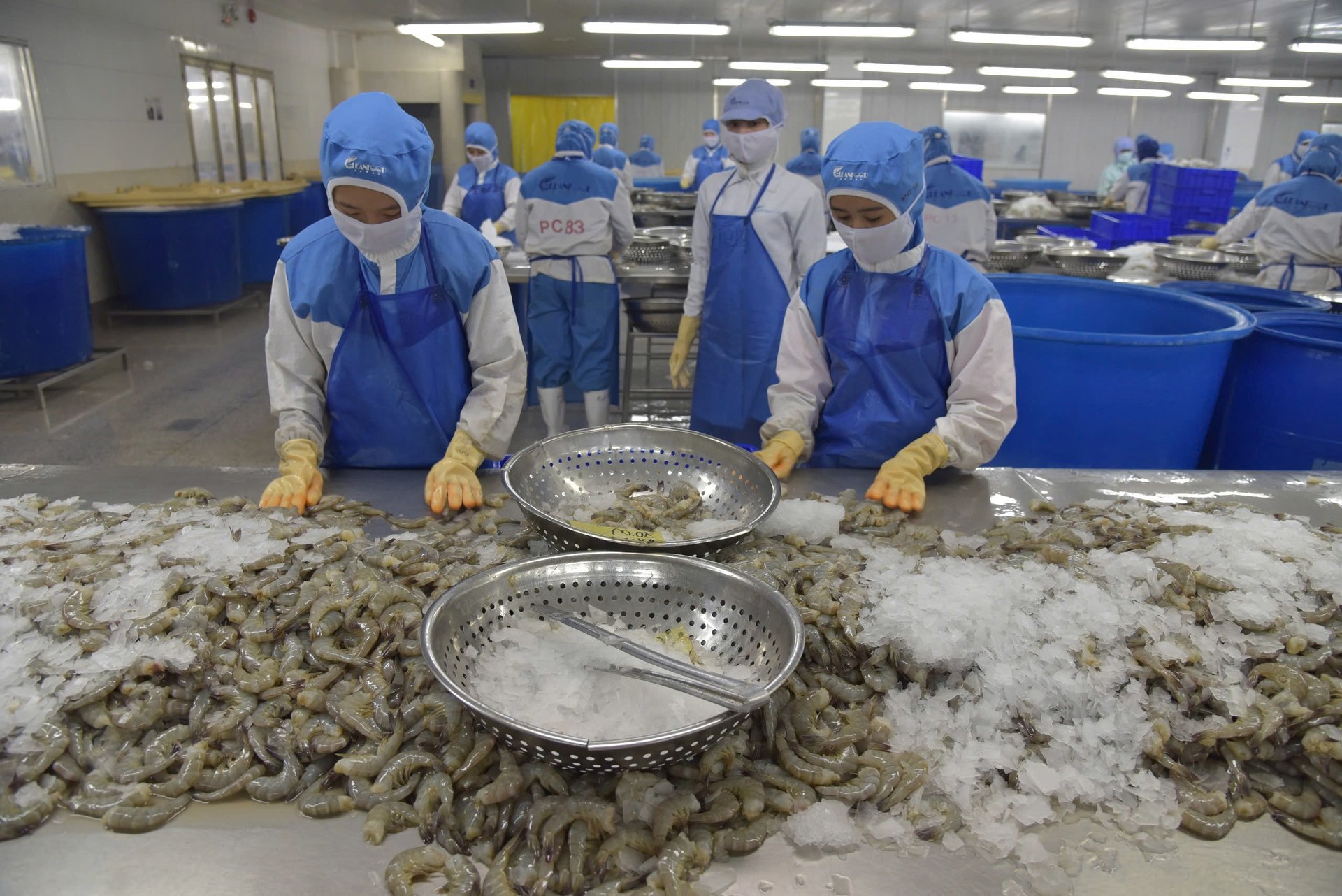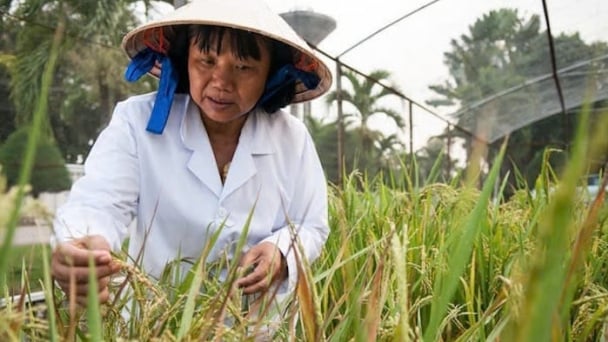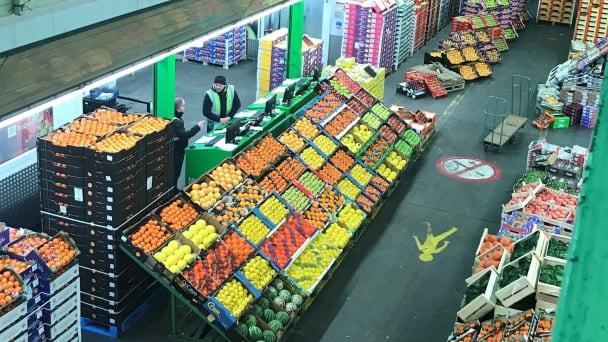May 17, 2025 | 02:48 GMT +7
May 17, 2025 | 02:48 GMT +7
Hotline: 0913.378.918
May 17, 2025 | 02:48 GMT +7
Hotline: 0913.378.918
On April 9, U.S. President Donald Trump's reciprocal tariff policy officially took effect, including a 46% tariff imposed on Vietnam. In addition to Vietnam, 85 other countries also faced higher countervailing duties today.
With such a significant tax disparity, Vietnamese seafood, especially shrimp, one of the country’s billion-dollar export products to the U.S. in 2024, has become nearly uncompetitive, particularly when Ecuador faces only a 10% tariff.

Vietnamese shrimp exports will struggle to remain competitive in the U.S. market. Photo: Hong Tham.
According to the Vietnam Association of Seafood Exporters and Producers (VASEP), the United States has long been Vietnam’s largest and most traditional market for shrimp exports, consistently accounting for around 20% of the country’s total shrimp export revenue.
Vietnam’s shrimp export turnover to the U.S. has fluctuated between USD 800 million and USD 1 billion annually, reaching a record high of USD 1 billion in 2021. As of now, approximately 230 Vietnamese seafood enterprises are actively engaged in exporting shrimp to the U.S. market.
A 46% tariff makes it impossible for businesses to compete, while consumers, even those willing to support, are unlikely to afford the added cost.
Previously, Vietnamese exporters had anticipated a possible tariff rate of around 10%, but the actual figure turned out to be multiple times higher. Without timely intervention from the Vietnamese government or successful negotiations to revise the tax rate, a complete withdrawal from the U.S. market is no longer a distant possibility.
Another growing concern is the tariff’s point of application. If U.S. authorities decide to calculate duties based on the date goods arrive at port, rather than the date of shipment from Vietnam, shipments that departed before April 5 but have not yet reached the U.S. could still be subject to the new tariff. This scenario could lead to serious financial losses. Estimates show that a single shipment worth USD 5 million could incur more than USD 2 million in additional costs if subjected to the 46% tariff—an impact that could devastate small and medium-sized exporters already operating under tight margins.
In addition to the newly imposed import duties, Vietnam’s shrimp exports are also under pressure from two ongoing legal cases in the U.S.: an anti-dumping (AD) investigation and a countervailing duty (CVD) case.
According to Shrimpinsights, while it is still too early to make definitive forecasts, U.S. President Donald Trump's new trade policy is clearly expected to have a significant short-term impact, and potentially far-reaching effects in the medium and long term, on global shrimp trade flows.
Countries such as Ecuador and several smaller shrimp-producing nations, including Argentina, Honduras, Mexico, Guatemala, Peru, and Saudi Arabia, are poised to gain a clear competitive advantage over most Asian exporters. These countries are well-positioned to capitalize on the situation and potentially expand their market share in the U.S. and beyond.

Ecuador and some smaller shrimp-producing countries like Argentina, Honduras, Mexico, Guatemala, Peru, and Saudi Arabia will have a distinct competitive advantage over most Asian countries. Photo: Ma. Fernanda Vílches.
Ecuador and other Latin American shrimp producers are expected to ramp up their production capacity for peeled and value-added shrimp products categories that are currently in high demand in the U.S. market. This shift comes at a strategic moment, as demand from China remains uncertain. Expanding their presence in the U.S. could help Ecuador mitigate risks associated with its reliance on the Chinese market.
Among Asian exporters, despite facing a 26% tariff, India still maintains a relative advantage compared to other major suppliers such as Indonesia (32%), Thailand (36%), and Vietnam (46%). India is likely to focus on product segments that Latin American producers are not yet positioned to supply.
Although share prices of Indian shrimp companies dropped sharply overnight in response to the U.S. tariff announcement, the country’s shrimp sector has demonstrated resilience in the face of previous global market shocks. Indian exporters may be able to hold onto their market share in categories where Latin American supply is still limited.
India is also expected to strengthen its relationships with U.S. retailers while expanding exports to the EU and other markets with peeled and processed shrimp products. Additionally, India may diversify into other seafood species and continue developing its value chain across aquaculture, processing, and export sectors.
Producers in Indonesia and Vietnam are facing the most challenging circumstances, with high production costs, steep U.S. tariffs, and intense competition from Ecuador and India across other international markets. Developing domestic markets will take time, and gaining ground in alternative export destinations will not be easy.
Smaller suppliers such as Bangladesh and Sri Lanka are likely to be hit even harder and may find it extremely difficult to continue exporting to the U.S. under the current conditions.
On the U.S. side, domestic shrimp farmers and fishermen may see an opportunity to increase their production and market share, benefiting from the new competitive landscape. However, they are unlikely to meet the bulk of domestic shrimp demand due to persistent limitations in production capacity, which go beyond pricing factors.
Translated by Phuong Linh
![Multi-channel, multi-directional Vietnamese agricultural markets: [7] Deep processing makes global reach easy](https://t.ex-cdn.com/nongnghiepmoitruong.vn/608w/files/huytd/2025/05/16/2946-che-bien-sau-chia-khoa-vang-nang-tam-nong-san-viet-tren-ban-do-the-gioi-080603_110-093858.jpg)
(VAN) The application of deep processing technology is helping Vietnamese agricultural products enhance their value, create competitive advantages, and open doors to conquer global consumers.
![Multi-channel, multi-directional Vietnamese agricultural markets: [6] Agri products go online](https://t.ex-cdn.com/nongnghiepmoitruong.vn/608w/files/content/2024/12/10/1-113313_954.jpg)
(VAN) Bringing agri products onto e-commerce platforms is an effective way to build a brand that many businesses, cooperatives, and agricultural production households are doing.

(VAN) Veterinary training should focus on quality, not just quantity. Veterinarians also need more options to pursue specialized training.

(VAN) The veterinary industry needs to be viewed objectively and further invested in to properly demonstrate its role and importance in the new context.

(VAN) The number of veterinarians graduating each year is not enough to meet actual needs, hence a difficult problem for the growing livestock industry.

(VAN) The strategic partnership between Cambodia, the Philippines, Vietnam, and CGIAR ensures that innovative solutions effectively address national priorities for food system development.

(VAN) This was affirmed by the UK Minister of State at the Department for Environment, Food and Rural Affairs during a working session with Deputy Minister Tran Thanh Nam on May 13.